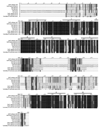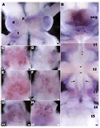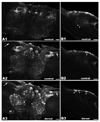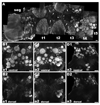Cloning and distribution of a putative octopamine/tyramine receptor in the central nervous system of the freshwater prawn Macrobrachium rosenbergii
- PMID: 20558147
- PMCID: PMC2920218
- DOI: 10.1016/j.brainres.2010.06.021
Cloning and distribution of a putative octopamine/tyramine receptor in the central nervous system of the freshwater prawn Macrobrachium rosenbergii
Abstract
There is ample evidence linking octopamine (OA) and tyramine (TA) to several neurophysiological functions in arthropods. In our laboratory we use the freshwater prawn Macrobrachium rosenbergii to study the neural basis of aggressive behavior. As a first step towards understanding the possible role of these amines and their receptors in the modulation of interactive behaviors, we have cloned a putative octopamine/tyramine receptor. The predicted sequence of the cloned OA/TA(Mac) receptor consists of 1,579 base pairs (bp), with an open reading frame of 1,350bp that encodes a 450 amino acid protein. This putative protein displays sequence identities of 70% to an Aedes aegypti mosquito TA receptor, followed by 60% to a Stegomyia aegypti mosquito OA receptor, 59% and 58% to the migratory locust TA-1 and -2 receptors respectively, and 57% with the silkworm OA receptor. We also mapped the OA/TA(Mac) receptor distribution by in-situ hybridization to the receptor's mRNA, and by immunohistochemistry to its protein. We observed stained cell bodies for the receptor's mRNA, mainly in the midline region of the thoracic and in the abdominal ganglia, as well as diffuse staining in the brain ganglia. For the receptor's protein, we observed extensive punctate staining within the neuropil and on the membrane of specific groups of neurons in all ganglia throughout the CNS, including the brain, the midline region and neuropiles of the thoracic ganglia, and ventral part and neuropiles of the abdominal ganglia. The same pattern of stained cells was observed on the thoracic and abdominal ganglia in both in-situ hybridization and immunohistochemistry experiments. Diffuse staining observed with in-situ hybridization also coincides with punctate staining observed in brain, SEG, thoracic, and abdominal ganglia in immunohistochemical preparations. This work provides the first step towards characterizing the neural networks that mediate octopaminergic signaling in prawn.
Published by Elsevier B.V.
Figures





Similar articles
-
Characterization of a prawn OA/TA receptor in Xenopus oocytes suggests functional selectivity between octopamine and tyramine.PLoS One. 2014 Oct 28;9(10):e111314. doi: 10.1371/journal.pone.0111314. eCollection 2014. PLoS One. 2014. PMID: 25350749 Free PMC article.
-
Distribution of dopamine and octopamine in the central nervous system and ovary during the ovarian maturation cycle of the giant freshwater prawn, Macrobrachium rosenbergii.Tissue Cell. 2009 Dec;41(6):430-42. doi: 10.1016/j.tice.2009.05.001. Epub 2009 Jul 24. Tissue Cell. 2009. PMID: 19631953
-
Cloning and immunoreactivity of the 5-HT 1Mac and 5-HT 2Mac receptors in the central nervous system of the freshwater prawn Macrobrachium rosenbergii.J Comp Neurol. 2009 Apr 1;513(4):399-416. doi: 10.1002/cne.21979. J Comp Neurol. 2009. PMID: 19184976 Free PMC article.
-
Insect octopamine receptors: a new classification scheme based on studies of cloned Drosophila G-protein coupled receptors.Invert Neurosci. 2005 Nov;5(3-4):111-8. doi: 10.1007/s10158-005-0001-z. Epub 2005 Oct 24. Invert Neurosci. 2005. PMID: 16211376 Review.
-
Tyramine: from octopamine precursor to neuroactive chemical in insects.Gen Comp Endocrinol. 2009 May 15;162(1):18-26. doi: 10.1016/j.ygcen.2008.05.021. Epub 2008 Jun 8. Gen Comp Endocrinol. 2009. PMID: 18588893 Review.
Cited by
-
Deep sequencing of transcriptomes from the nervous systems of two decapod crustaceans to characterize genes important for neural circuit function and modulation.BMC Genomics. 2016 Nov 4;17(1):868. doi: 10.1186/s12864-016-3215-z. BMC Genomics. 2016. PMID: 27809760 Free PMC article.
-
Tyraminergic modulation of agonistic outcomes in crayfish.J Comp Physiol A Neuroethol Sens Neural Behav Physiol. 2018 May;204(5):465-473. doi: 10.1007/s00359-018-1255-3. Epub 2018 Feb 27. J Comp Physiol A Neuroethol Sens Neural Behav Physiol. 2018. PMID: 29488014
-
Identification of putative amine receptor complement in the eyestalk of the crayfish, Procambarus clarkii.Invert Neurosci. 2019 Sep 23;19(4):12. doi: 10.1007/s10158-019-0232-z. Invert Neurosci. 2019. PMID: 31549228
-
Transcriptome analysis of reproductive tract tissues of male river prawn Macrobrachium americanum.Mol Biol Rep. 2024 Feb 1;51(1):259. doi: 10.1007/s11033-023-09125-6. Mol Biol Rep. 2024. PMID: 38302799
-
Multiple Biogenic Amine Receptor Types Modulate Spider, Cupiennius salei, Mechanosensory Neurons.Front Physiol. 2018 Jul 9;9:857. doi: 10.3389/fphys.2018.00857. eCollection 2018. Front Physiol. 2018. PMID: 30050453 Free PMC article.
References
-
- Antonsen BL, Paul DH. Serotonergic and octopaminergic systems in the squat lobster Munida quadrispina (Anomura, Glatheidae) J Comp Neurol. 2001;439:450–468. - PubMed
-
- Arakawa S, Gocayne JD, McCombie WR, Urquhart DA, Hall LM, Fraser CM, Vanter JC. Cloning, localization, and permanent expression of a Drosophila octopamine receptor. Neuron. 1990;4:343–354. - PubMed
-
- Axelrod J, Saavedra JM. Octopamine. Nature. 1977;265:501–504. - PubMed
-
- Barki A, Karplus I, Goren M. The agonistic behavior of the three male morphotypes of the freshwater prawn Macrobrachium rosenbergii (Crustacea, Palaemonidae) Behavior. 1991a;116:252–277.
-
- Barki A, Karplus I, Goren M. Morphotype related dominance hierarchies in males of Macrobrachium rosenbergii (Crustacea, Palaemoidae) Behavior. 1991b;117:145–160.
Publication types
MeSH terms
Substances
Grants and funding
- NIH RO1 NS39103/NS/NINDS NIH HHS/United States
- R24 MH048190/MH/NIMH NIH HHS/United States
- R25 GM061838/GM/NIGMS NIH HHS/United States
- R01 NS064259/NS/NINDS NIH HHS/United States
- S06GM008224/GM/NIGMS NIH HHS/United States
- G12RR0305/RR/NCRR NIH HHS/United States
- G12 RR003051/RR/NCRR NIH HHS/United States
- S06 GM008224/GM/NIGMS NIH HHS/United States
- P20 GM103642/GM/NIGMS NIH HHS/United States
- G12 MD007600/MD/NIMHD NIH HHS/United States
- R25-GM061838/GM/NIGMS NIH HHS/United States
- R01 NS039103/NS/NINDS NIH HHS/United States
- SC3 GM084763/GM/NIGMS NIH HHS/United States
- G12 RR003050/RR/NCRR NIH HHS/United States
LinkOut - more resources
Full Text Sources
Research Materials

